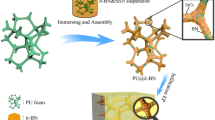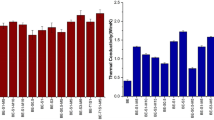Abstract
A facile and effective method has been developed to prepare highly thermal conductive composites with three-dimensional boron nitride (BN) network based on epoxy spheres (ESs). ESs synthesized and coated with fBN (ESs@fBN) were added into epoxy matrix to construct networks. The formation mechanism of ESs morphology and properties of composites with different content of ESs@fBN were investigated. The thermal conductivity of the composites was enhanced from 0.18 W m−1 K−1 of neat epoxy to 0.67 W m−1 K−1 of composite with only 7.4 wt% fBN. A 272% increment is attributed to the occupation of ESs, which can facilitate to form effective heat dissipating paths at low content of filler and improve the thermal conductivity of the composites. Moreover, the addition of reactive ESs and fBN could lead to an increase in storage modulus and Tg of epoxy resin. This method will give a new consideration for the preparation of thermally conductive composites.













Similar content being viewed by others

References
Burger N, Laachachi A, Ferriol M, Lutz M, Toniazzo V, Ruch D (2016) Review of thermal conductivity in composites: mechanisms, parameters and theory. Prog Polym Sci 61:1–28. https://doi.org/10.1016/j.progpolymsci.2016.05.001
Idumah CI, Hassan A (2016) Recently emerging trends in thermal conductivity of polymer nanocomposites. Rev Chem Eng. https://doi.org/10.1515/revce-2016-0004
Jin F-L, Li X, Park S-J (2015) Synthesis and application of epoxy resins: a review. J Ind Eng Chem 29:1–11. https://doi.org/10.1016/j.jiec.2015.03.026
Wang X, Li W, Zhang Z, Chen K, Gan W (2019) Selective localization of multi-walled carbon nanotubes in epoxy/polyetherimide system and properties of the conductive composites. J Appl Polym Sci. https://doi.org/10.1002/app.47911
Song Q, Zhu W, Deng Y, He D, Feng J (2018) Enhanced thermal conductivity and mechanical property of flexible poly (vinylidene fluoride)/boron nitride/graphite nanoplatelets insulation films with high breakdown strength and reliability. Compos Sci Technol 168:381–387. https://doi.org/10.1016/j.compscitech.2018.10.015
He D, Wang Y, Song S, Liu S, Deng Y (2017) Significantly enhanced dielectric performances and high thermal conductivity in poly(vinylidene fluoride)-based composites enabled by SiC@SiO2 core-shell whiskers alignment. ACS Appl Mater Interfaces 9:44839–44846. https://doi.org/10.1021/acsami.7b14751
Zhang X, Xia X, You H et al (2020) Design of continuous segregated polypropylene/Al2O3 nanocomposites and impact of controlled Al2O3 distribution on thermal conductivity. Compos A Appl Sci Manuf. https://doi.org/10.1016/j.compositesa.2020.105825
Jiang X, Ma P, You F, Yao C, Yao J, Liu F (2018) A facile strategy for modifying boron nitride and enhancing its effect on the thermal conductivity of polypropylene/polystyrene blends. RSC Adv 8:32132–32137. https://doi.org/10.1039/c8ra06140h
Jin X, Li W, Liu Y, Gan W (2020) Self-constructing thermal conductive filler network via reaction-induced phase separation in BNNSs/epoxy/polyetherimide composites. Compos A Appl Sci Manuf. https://doi.org/10.1016/j.compositesa.2019.105727
Liu Z, Li J, Liu X (2020) Novel functionalized bn nanosheets/epoxy composites with advanced thermal conductivity and mechanical properties. ACS Appl Mater Interfaces 12:6503–6515. https://doi.org/10.1021/acsami.9b21467
Pan D, Li Q, Zhang W et al (2021) Highly thermal conductive epoxy nanocomposites filled with 3D BN/C spatial network prepared by salt template assisted method. Compos B Eng. https://doi.org/10.1016/j.compositesb.2021.108609
Wang R, Cheng H, Gong Y et al (2019) Highly thermally conductive polymer composite originated from assembly of boron nitride at an oil-water interface. ACS Appl Mater Interfaces 11:42818–42826. https://doi.org/10.1021/acsami.9b15259
Xiao C, Guo Y, Tang Y et al (2020) Epoxy composite with significantly improved thermal conductivity by constructing a vertically aligned three-dimensional network of silicon carbide nanowires/boron nitride nanosheets. Compos B Eng. https://doi.org/10.1016/j.compositesb.2020.107855
Zhang S, Li X, Guan X et al (2017) Synthesis of pyridine-containing diamine and properties of its polyimides and polyimide/hexagonal boron nitride composite films. Compos Sci Technol 152:165–172. https://doi.org/10.1016/j.compscitech.2017.09.026
Wang D, Wei H, Lin Y, Jiang P, Bao H, Huang X (2021) Achieving ultrahigh thermal conductivity in Ag/MXene/epoxy nanocomposites via filler-filler interface engineering. Compos Sci Technol. https://doi.org/10.1016/j.compscitech.2021.108953
Dong J, Cao L, Li Y, Wu Z, Teng C (2020) Largely improved thermal conductivity of PI/BNNS nanocomposites obtained by constructing a 3D BNNS network and filling it with AgNW as the thermally conductive bridges. Compos Sci Technol. https://doi.org/10.1016/j.compscitech.2020.108242
Liu Y, Yang X, Yue L, Li W, Gan W, Chen K (2019) Selective dispersion of silver nanowires in epoxy/polyetherimide binary composites with enhanced electrical conductivity: a study of curing kinetics and morphology. Polym Compos 40:4390–4401. https://doi.org/10.1002/pc.25301
Wang S, Li W, Jin X, Wu J, Chen K, Gan W (2021) Facile fabrication of three-dimensional thermal conductive composites with synergistic effect of multidimensional fillers. J Mater Sci 56:12671–12685. https://doi.org/10.1007/s10853-021-06105-8
Pakdel A, Bando Y, Golberg D (2014) Nano boron nitride flatland. Chem Soc Rev 43:934–959. https://doi.org/10.1039/c3cs60260e
Fang L, Wu C, Qian R, Xie L, Yang K, Jiang P (2014) Nano–micro structure of functionalized boron nitride and aluminum oxide for epoxy composites with enhanced thermal conductivity and breakdown strength. RSC Adv 4:21010–21017. https://doi.org/10.1039/c4ra01194e
Chen H, Ginzburg VV, Yang J et al (2016) Thermal conductivity of polymer-based composites: fundamentals and applications. Prog Polym Sci 59:41–85. https://doi.org/10.1016/j.progpolymsci.2016.03.001
Ryu SH, Cho H-B, Kwon Y-T et al (2020) Quasi-isotropic thermal conduction in percolation networks: using the pore-filling effect to enhance thermal conductivity in polymer nanocomposites. ACS Appl Polymer Mater 3:1293–1305. https://doi.org/10.1021/acsapm.0c01061
Zhang Y, Shen Y, Shi K, Wang T, Harkin-Jones E (2018) Constructing a filler network for thermal conductivity enhancement in epoxy composites via reaction-induced phase separation. Compos A Appl Sci Manuf 110:62–69. https://doi.org/10.1016/j.compositesa.2018.04.009
Feng C, Ni H, Chen J, Yang W (2016) Facile method to fabricate highly thermally conductive graphite/PP composite with network structures. ACS Appl Mater Interfaces 8:19732–19738. https://doi.org/10.1021/acsami.6b03723
Han W, Bai Y, Liu S et al (2017) Enhanced thermal conductivity of commercial polystyrene filled with core-shell structured BN@PS. Compos A Appl Sci Manuf 102:218–227. https://doi.org/10.1016/j.compositesa.2017.08.012
Huang J, Yang W, Zhu J, Fu L, Li D, Zhou L (2019) Silver nanoparticles decorated 3D reduced graphene oxides as hybrid filler for enhancing thermal conductivity of polystyrene composites. Compos A Appl Sci Manuf 123:79–85. https://doi.org/10.1016/j.compositesa.2019.05.002
Sun R, Zhang H-B, Liu J et al (2017) Highly conductive transition metal carbide/carbonitride(MXene)@polystyrene nanocomposites fabricated by electrostatic assembly for highly efficient electromagnetic interference shielding. Adv Func Mater. https://doi.org/10.1002/adfm.201702807
Vu MC, Bae YH, Yu MJ, Islam MA, Kim S-R (2018) Core-shell structured carbon nanotube-poly(methylmethacrylate) beads as thermo-conductive filler in epoxy composites. Compos A Appl Sci Manuf 109:55–62. https://doi.org/10.1016/j.compositesa.2018.02.021
Wang X, Wu P (2017) Preparation of highly thermally conductive polymer composite at low filler content via a self-assembly process between polystyrene microspheres and boron nitride nanosheets. ACS Appl Mater Interfaces 9:19934–19944. https://doi.org/10.1021/acsami.7b04768
Wang Z-G, Gong F, Yu W-C et al (2018) Synergetic enhancement of thermal conductivity by constructing hybrid conductive network in the segregated polymer composites. Compos Sci Technol 162:7–13. https://doi.org/10.1016/j.compscitech.2018.03.016
Yuan H, Wang Y, Li T et al (2019) Fabrication of thermally conductive and electrically insulating polymer composites with isotropic thermal conductivity by constructing a three-dimensional interconnected network. Nanoscale 11:11360–11368. https://doi.org/10.1039/c9nr02491c
Ralphs M, Kong W, Wang RY, Rykaczewski K (2019) Thermal conductivity enhancement of soft polymer composites through magnetically induced percolation and particle-particle contact engineering. Adv Mater Interfaces. https://doi.org/10.1002/admi.201801857
Wu X, Yang X, Yu R, Zhao X-J, Zhang Y, Huang W (2018) Highly crosslinked and uniform thermoset epoxy microspheres: preparation and toughening study. Polymer 143:145–154. https://doi.org/10.1016/j.polymer.2018.04.011
Hibino K, Kimura Y (2000) Epoxy resin particles, 2. An efficient synthetic method of epoxy resin particles in organic solvent by the aid of modified polyolefins as dispersant. Macromol Mater Eng 283:62–67. https://doi.org/10.1007/s003960050556
Hibino K, Kimura Y (1999) Epoxy resin particles. I. Spontaneous particle formation by the polymerization reaction of epoxy resin in a stationary system using polyethers as organic media. Colloid Polym Sci 278:565–570. https://doi.org/10.1007/s003960050556
Ambrogi V, Cosco S, Carfagna C, Cicala G, Oliveri L, Recca A (2006) Comparison of the effect of epoxy microspheres on the thermomechanical and rheological properties of an epoxy resin system. Polym Eng Sci 46:1739–1747. https://doi.org/10.1002/pen.20647
Carfagna C, Ambrogi V, Cicala G, Pollicino A, Recca A, Costa G (2004) Reactive microspheres as active fillers for epoxy resins. J Appl Polym Sci 93:2031–2044. https://doi.org/10.1002/app.20678
Guo Y, Lyu Z, Yang X et al (2019) Enhanced thermal conductivities and decreased thermal resistances of functionalized boron nitride/polyimide composites. Compos B Eng 164:732–739. https://doi.org/10.1016/j.compositesb.2019.01.099
Acknowledgements
This work was supported by National Natural Science Foundation (Grant No. 51603121).
Author information
Authors and Affiliations
Corresponding authors
Ethics declarations
Conflict of interest
The authors declare no competing financial interest.
Additional information
Handling Editor: Maude Jimenez.
Publisher's Note
Springer Nature remains neutral with regard to jurisdictional claims in published maps and institutional affiliations.
Supplementary Information
Below is the link to the electronic supplementary material.
Rights and permissions
About this article
Cite this article
Yuan, W., Li, W., Zhu, S. et al. 3D-network of hybrid epoxy-boron nitride microspheres leading to epoxy composites of high thermal conductivity. J Mater Sci 57, 11698–11713 (2022). https://doi.org/10.1007/s10853-022-07333-2
Received:
Accepted:
Published:
Issue Date:
DOI: https://doi.org/10.1007/s10853-022-07333-2



